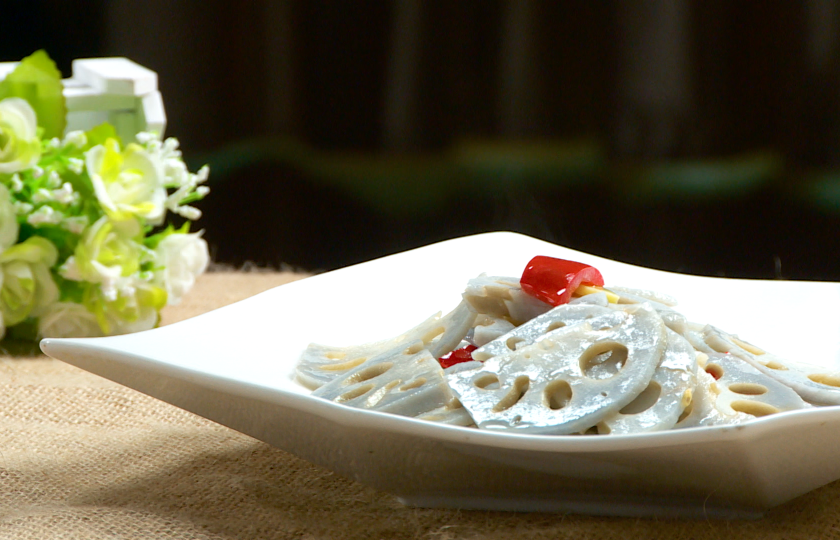Lotus Root Stir-fry


Today I will share a wonderful way to make lotus root slices. The taste is crisp and refreshing. The method is simple. Come and try making it with me!
About stir-fried lotus root slices
Stir-fried lotus root slices is a classic Chinese home-cooked dish. It is made with lotus root slices as the raw material and is made with ingredients such as peppers, ginger, and shallots. It has a crisp taste and a faint fresh fragrance. It is a dish suitable for all ages.

The nutritional and edible value of crispy lotus root slices is very high. Eating an appropriate amount can supplement sufficient nutrients for the human body and is beneficial to human health.
Ingredients Needed and Substitutions
Main ingredients
Lotus root: The main ingredient for making stir-fried lotus root slices, providing a crisp taste.
Additional ingredients
Ginger, shallots: Both have a special fragrance. Ginger is used to remove fishy smell and add flavor. Shallots are used to enhance fragrance and decorate.
Red pepper: Provides spiciness and adds color and a slightly spicy taste.
Condiments
Salt: Basic condiment to bring out the natural sweetness of lotus root.
White vinegar: Provides sourness, keeps the lotus root slices white in color, and adds sourness.
Oil: Used for stir-frying during the cooking process.
Substitutions:
Ginger: Can be replaced by garlic.
Red pepper: Can be replaced by green pepper.
Shallots: Can be replaced by leeks.
White vinegar: Can be replaced by lemon juice.
How to choose lotus root
Techniques for choosing lotus root:
Look at the color
The skin of fresh lotus root should be slightly yellowish and have a faint earthy smell. If the color of the lotus root is black or too white, it may not be fresh enough.
Look at the appearance
Choose lotus root with smooth skin, no damage and black spots. Damaged lotus root is easy to deteriorate and affect the taste and quality.
Choose lotus root with thicker and shorter nodes. The maturity is higher and the taste is better.
Look at the holes
When choosing, you can observe the holes of the lotus root slices. The cross-section of crispy lotus root usually has nine holes. It has high water content and a crisp taste, suitable for stir-frying or cold salad.
Look at the weight
For lotus roots of the same size, the heavier lotus root has less water content and is suitable for stewing; the lighter crispy lotus root has high water content and is suitable for stir-frying.
Smell the smell
Fresh lotus root should have a faint earthy smell and no sour smell or other chemical reagent smell. If the lotus root has a sour smell or other peculiar smell, it is not recommended to choose.
Look at taste needs
You can choose lotus root slices according to your own taste preference. For example, if we are stir-frying lotus root slices, we should choose crispy lotus root to maintain a crisp taste.
For stewing, it is suitable to choose lotus root with floury texture. The taste is powdery and glutinous, and it can absorb the taste of soup.
Tips for Success
Ingredient processing
Soaking lotus root slices: Lotus root is easily oxidized. Therefore, after slicing, it should be put into clear water in time to soak to prevent it from turning black. Soaking isolates the air and can keep the lotus root slices white.
Side dishes: Cut ginger, red pepper, and shallots into diamond-shaped slices or blocks and sections. It is not only beautiful but also can ensure rapid heating and release of flavor during the stir-frying process.
Cooking skills
Blanching ingredients: Lotus root slices should be blanched first. When blanching, add salt and white vinegar. Salt can make the lotus root slices taste in advance. White vinegar can not only keep the lotus root slices white but also increase the crispness of the lotus root slices to a certain extent.
Stir-frying sequence
Stir-fry ginger slices first. Use the pungent taste of ginger slices to stimulate the fragrance of scallions and red peppers, making the flavor layers of the whole dish more abundant. Then put in the lotus root slices. The sequence is reasonable.
Seasoning skills
Salt and white vinegar are the main condiments. They should be added at the end. The final adjustment can make the taste more accurately meet your own preferences. Adding white vinegar again helps maintain the crispness of lotus root slices.
Heat control
When making stir-fried lotus root slices, it is recommended to use medium-low heat mainly. The description of stir-frying ginger slices for a few seconds and stir-frying scallion sections and red pepper blocks until there is a fragrant smell all imply the use of medium-low heat to avoid the situation where the surface of the lotus root slices is scorched while the inside is not fully cooked.
INGREDIENTS
Main Ingredients
-
·300g lotus root
Additional Ingredients
-
·10g ginger
-
·10g red pepper
-
·10g shallots
Seasonings
-
·8g salt
-
·15ml white vinegar
-
·15ml oil
COOKING STEP
Step 1
Ingredient pretreatment:
Wash 300 grams of lotus root, cut it into thin slices about 3 - 4 millimeters thick, and put it into clear water and drop a little white vinegar to soak to prevent the lotus root slices from turning black due to oxidation.
Cut 10 grams of ginger into diamond-shaped slices, 10 grams of red pepper into diamond-shaped blocks, and divide 10 grams of shallots into white parts and green parts. Cut the white parts of shallots into sections for later use.

Step 2
Blanching lotus root slices:
Pour 500 milliliters of clear water into the pot and turn on high heat to boil the water.
After the water boils, add 5 grams of salt and stir well, then pour in 10 milliliters of white vinegar.
Put the soaked lotus root slices into the pot and keep the water boiling. Blanch for 2 minutes and then take them out and soak them in cold water.

Step 3
Stir-fry seasonings to release fragrance:
Pour 15 milliliters of oil into the pot, heat it on medium-low heat. When the oil is hot, put in the sliced ginger and quickly stir-fry to bring out the fragrance.
Add scallion sections and red pepper blocks, turn to medium heat and stir-fry, continuously turn the ingredients and stir-fry until there is a distinct fragrance.

Step 4
Stir-fry together and season:
Take out the lotus root slices from the cold water and drain the water, then pour them into the pot.
Add 3 grams of salt and 5 milliliters of white vinegar, and quickly stir with a spatula.

Step 5
Take out and plate:
Stir-fry until the lotus root slices are evenly coated with seasonings. Take out the lotus root slices and plate them. Sprinkle with green shallots as a decoration and then it can be served and tasted.

More delicious home-cooked dishes worth trying
Delicious Braised Prawns Recipe
Skillful Braised Beef Recipe: The Art of Slow Cooking
Easy Tomato-Braised Beef: A hearty one-pot comfort meal
Serving Suggestions
Recommended combinations
Rice: Stir-fried lotus root slices have a crisp taste and a sweet taste. They are a classic combination with white rice.
Steamed buns: If you prefer pasta, you can eat it with steamed buns. Steaming hot steamed buns with stir-fried lotus root slices are also an excellent choice.
Steamed fish: Stir-fried lotus root slices have a single nutrition. Fish is rich in high-quality protein. Steamed fish combined with stir-fried lotus root slices not only enriches the taste levels but also increases the nutritional value.
White gourd and meatball soup: Stir-fried lotus root slices can also be eaten with white gourd and meatball soup. It is refreshing and appetizing and makes people's appetite increase greatly.
Tomato and egg soup: Tomato and egg soup is sweet and sour. Eating it with stir-fried lotus root slices can highlight the sweetness of lotus root slices.
Serving suggestions
Eat while hot: After stir-fried lotus root slices are out of the pot, it is recommended to eat them while they are hot. The lotus root slices just out of the pot have the crispest taste and can stimulate the taste buds to the greatest extent.
Eat in moderation: Although stir-fried lotus root slices are delicious, it is not recommended to eat too much to avoid aggravating the burden on your own gastrointestinal tract and causing discomfort symptoms such as abdominal pain and diarrhea.
FAQs:
To solve this problem, immediately put the sliced lotus root into clear water for soaking after cutting, and you can add an appropriate amount of white vinegar to the water. This can effectively isolate the air and prevent the lotus root slices from turning black due to oxidation.
To solve this problem, when choosing lotus root, you can choose nine-hole lotus root with a relatively slender appearance and smaller holes. This kind of lotus root usually has a relatively crisp taste.
Secondly, strictly control the blanching time to about 2 minutes. When stir-frying, move quickly to avoid prolonged heating of the lotus root slices.
Cut the lotus root slices thinner. Add salt and white vinegar when blanching to taste in advance. During the stir-frying process, stir well to make the lotus root slices evenly contact the seasonings. And you can appropriately extend the stir-frying time to make the lotus root slices better absorb the taste of seasonings.
The lotus root slices should be fully drained before being put into the pot. During the stir-frying process, if there is too much soup, you can appropriately turn up the heat to thicken the soup to avoid affecting the taste of the dish.

















